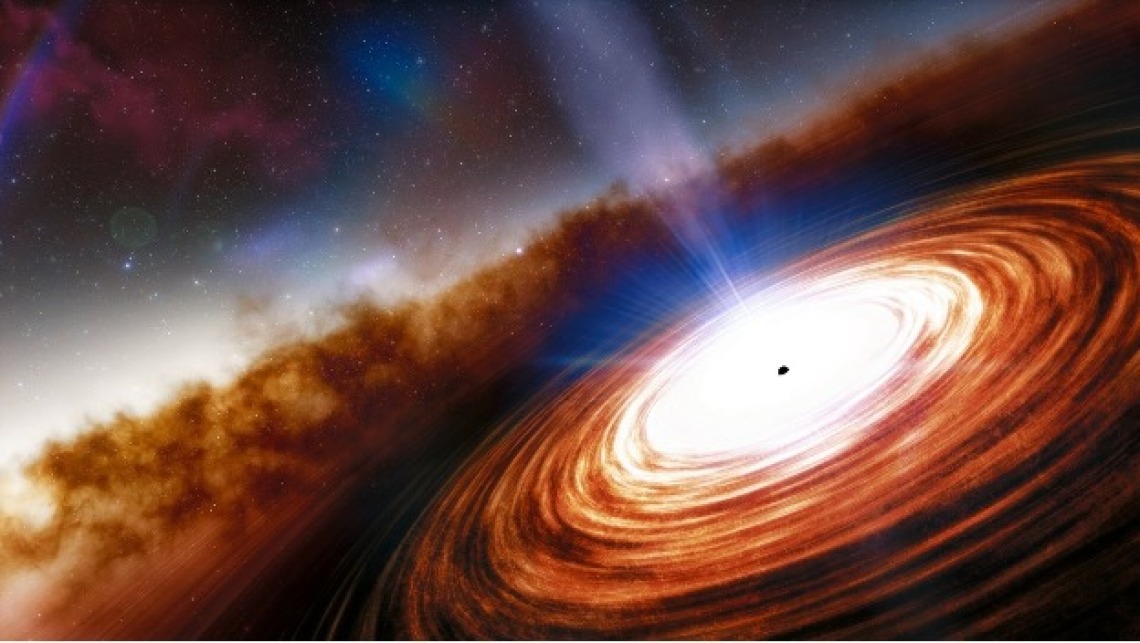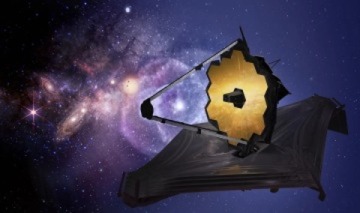'Mind-boggling' quasars and atmospheres of vaporized rock: UArizona astronomers explore cosmos with Webb Telescope

Artist’s impression of a high-redshift quasar as it would have appeared a few hundred million years after the Big Bang. Powered by a supermassive black hole at their center, such quasars can be 1000 times more luminous than the Milky Way galaxy. NOIRLab/NSF/AURA/J. da Silva
Competition to secure observing time for the world's most powerful space telescope is stiff – so stiff that for every nine applications submitted for the latest observation cycle for NASA's James Webb Space Telescope, only one was accepted.
The Space Telescope Science Institute, which made the final selections for JWST Cycle 3, approved two types of programs: those requiring primary observation time, dictating which part of the sky the telescope views, and those that rely on parallel observation time, which can occur simultaneously while one or more instruments on JWST are occupied with a primary project.
In a sea of national and international applicants, researchers from the University of Arizona Steward Observatory received 8% of the primary observation time for JWST Cyle 3 and 70% of the total parallel observation time, earning the university one of the highest observation allocations of any academic institution.
Observation cycles typically last one year and provide the astronomy community with a time period for scheduling and conducting observations. Cycle 3 begins on July 1.

UArizona Regents Professors Marcia and George Rieke and their respective science teams played key roles in developing two infrared instruments aboard NASA's James Webb Space Telescope. NASA
Of the roughly 6,000 astronomers who submitted proposals, one of the approved principal investigators is Steward Observatory graduate student Maria Pudoka. It was the first telescope proposal she had ever written. The team working alongside her includes collaborators from Europe, China and the U.S.
Her group, called EREBUS – which stands for the Epoch of Reionizaion and Early Black holes in the Universe Studies – builds on the work of the ASPIRE program, which aims to understand galaxy evolution and black hole growth in the early universe. Pudoka is interested in high redshift quasars – "mind bogglingly massive" black holes that formed only a few hundred million years after the Big Bang. The gravity of these enormous quasars makes them prime places to look for galaxy protoclusters – the prequels to galaxy clusters. Learning about protoclusters in the early universe helps astronomers understand the formation and assembly of galaxies, which are among the greatest concentrations of mass in the cosmos.
What sets Pudoka's research apart is her intent to study the most distant known quasar as measured by redshift, an astronomical measure of distance based on the way that light wavelengths change as they travel from large distances. While previous ASPIRE research has searched for galaxy protoclusters around quasars with redshifts up to roughly 6.5, Pudoka's target quasar has a redshift of 7.5. This corresponds to a distance of 13.01 billion light-years. In other words, light from this quasar reaching Earth shows it as it appeared when the universe was about 700 million years "young."
"We're pushing the boundary as far as we can," Pudoka said.
Students like Pudoka make up only 12% of the principal investigators accepted for JWST Cycle 3. UArizona research professor Eiichi Egami suspects that strong student researchers are drawn to Steward Observatory because of its legacy of involvement in instrumentation development for large-scale space science projects such as the Hubble Space Telescope and Spitzer Space Telescope. The teams that designed two major infrared instruments aboard JWST – MIRI and NIRcam – were led by Steward Observatory Regents Professors George Rieke and Marcia Rieke, respectively. This earned UArizona researchers a large allocation of ongoing guaranteed observation time with the telescope, in addition to the time awarded with each competitive cycle.
"Steward Observatory has succeeded in maintaining this positive cycle of getting these large NASA space mission programs that allow Steward to maintain outstanding people and recruit students. I think that the fact that we're getting so much observing time this cycle is the outcome of this whole process," Egami said. "It didn't just happen overnight. It's a long, successful history of this place, which is quite unique even in this big community of astronomers in the U.S."
Egami will lead a 600-hour program using parallel observation time during JWST Cycle 3. While other instruments on JWST are taking measurements in various parts of the sky for other research programs, Egami's SAPPHIRES program will simultaneously gather data with NIRCam, which will allow the team to seek distant, highly luminous objects across a larger area of sky than would be possible with the more limited primary observation time available for this cycle.
The NIRCam mode that SAPPHIRES will be using was originally designed as a mode for simply calibrating the telescope, but when Egami joined the NIRCam team at Steward Observatory, he recognized that the setting could be a powerful tool for the survey of high-redshift galaxies. He advocated for it and published papers with one of his students, Fengwu Sun, showing the value of the mode for collecting data. NIRCam is mainly an imaging camera, with a filter wheel in front of it that can provide images in different colors. Another wheel contains a pair of dispersing elements called Grism, which can work as a slitless spectrograph, dispersing all the light coming in from different sources and projecting hundreds of spectra instead of sharp images. The NIRCam Grism Wide Field Slitless Spectroscopy (WFSS) that Egami championed allows the instrument to collect many spectra for a wide field of galaxies, rather than focusing on one object at a time. Pudoka, who will also be using this mode for her program, calls it “a goldmine of a redshift machine.”
JWST Cycle 3 is the first time this observing mode has been made available for parallel observation time, and Egami looks forward to the amount of data this slitless mode will be able to collect for up to 600 hours across vast, random regions of space. “I’m really happy that this observing mode is realizing its potential, and my prediction turned out to be correct,” Egami said. “Now I’m in the position to obtain a huge amount of data through this observing mode. It gives me particular joy.”
Egami's program seeks explanations for many of the surprises that earlier JWST cycle observations unveiled. In particular, the space telescope showed that there are many more luminous galaxies in the young universe than scientists expected. This challenges astronomers' current understanding of galaxy formation and evolution.
"It's an interesting and exciting puzzle," Egami said. These incredibly bright, high-redshift galaxies are rare, so mapping a large area of sky will give the SAPPHIRES team a greater chance of finding more of them.
If the SAPPHIRES team can identify the locations of some of the brightest, most distant galaxies, the team will set the stage not just for further research using JWST but also for follow-up observations using powerful ground-based observatories, such as the Atacama Large Millimeter/submillimeter Array in Chile.
"Once we find these luminous galaxies, we can target them with ALMA to study the properties of gas and dust inside of them," Egami said. "We can also study them from other observatories at many different wavelengths to dissect the properties of these galaxies."
Another program, COSMOS-3D, was awarded 260 hours of primary time and 120 hours of parallel time to focus on one area of the sky and map it out. It is the largest program of the entire JWST cycle. The program, with a large team of co-principal investigators all from Steward Observatory – including Regents Professor and associate head of the Department of Astronomy Xiaohui Fan – will look for answers to some of the same questions that the SAPPHIRES team seeks, but rather than scanning the whole sky, the team will aim the telescope at one large area of the sky and map it thoroughly.
Together, the two programs will three-dimensionally map the early universe to understand its formation and to answer some of the questions raised by earlier JWST observations. In particular, COSMOS-3D aims to understand how early supermassive black holes grow, as well as how the initial large-scale structure of the universe, called the cosmic web, emerged.
JWST Cycle 3 also opens up greater possibilities for transdisciplinary discovery. Steward Observatory's NASA Sagan Fellow Megan Weiner Mansfield was selected to lead two programs this cycle, including one that seeks planets so hot that their atmospheres are made of vaporized rock.
Weiner Mansfield studied geosciences in at the University of Chicago, and is interested in studying "how exoplanets work," from their surfaces to their atmospheres and how the two interact. She said she was drawn to continue her studies at UArizona in large part because astronomers at Steward Observatory and the Lunar and Planetary Laboratory are "doing amazing research with telescopes and amazing research on planetary bodies and being able to combine both of those."
Without an underlying geological understanding of a distant planet, it's easy to mistake different kinds of planetary surfaces for atmospheres, Weiner Mansfield said, making it harder to accurately identify the kinds of planets that would be hospitable to life.
"If you look at Earth's ice caps, they are very reflective and kind of look similar to clouds in an atmosphere," Weiner Mansfield said. "I'm really interested in trying to get like geologists and astronomers to talk to each other more."
In this JWST cycle, Weiner Mansfield will study hot Venus-like planets that orbit close to their stars. As she uses temperature clues to unravel the geologic stories of these faraway planets, Weiner Mansfield can begin to draw comparisons to Earth.
NASA has already begun laying the groundwork for its next flagship mission: the Habitable Earths Observatory, to be launched later this decade. Weiner Mansfield sees her programs as a first step in paving the way for that mission: identifying which exoplanets have atmospheres, and figuring out what those atmospheres are made of. This early research will lay the foundation for geologically informed approaches to finding habitable planets.
"These programs that I have right now are all on planets that are probably too hot to have life," Weiner Mansfield said, "but what I really want to do someday is to look at planets that are cool enough that they might have life like what we have on Earth."
Read -- or listen to! -- the article on UA News.

